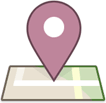
Context
What is contextual computing? It centers on hardware and software that understands you and offers the information you need based on what you’ve done, where you’ve been and where you are. It’s predictive. Google does this by giving you what you may want based on your search history. Facebook figures what you may like based on who you Like.
Contextual sensing happens now through applications like Highlight, which tells you something about who’s immediately around you. Alohar’s PlaceMe records where you’ve been and how long you’ve been there. The idea is that information like this will help us understand where we may want to go or what we may want or need to do.
This idea of context may have been nudged along by Qualcomm’s recent release of Gimbal, a new mobile system that takes the burden of ambient sensing off of the software and puts it into the hardware. This cuts the burden on the battery and may represent a critical flexion point in how all of this advances.
Contextual health
There’s nothing more contextual than health. I can’t help but think that The Age of Contextual Health is upon us. This will emerge as quantified self, biosensors, mobile technology and smart software come of age together. It used to be that health information found us through our social networks. Now it will intuitively find us based on where we are, what we’re doing and what we’re eating.
Geofencing will allow the delivery of specific information in certain areas of hospitals. Information from accelerometers and skin impedance sensors may help the patient with cardiac disease recognize when they’re going too far. Targeted educational materials on crohn’s disease may be available to a young mother waiting for an appointment in a pediatric gastroenterology clinic.
Understand where people eat and you can begin to understand what kills them. My phone knows what restaurant I’m in, who I’m with, where I’ve come from and where I’m going. It also knows how many calories I’ve burned along the way. The epidemiologic impact of this kind of data is staggering. I, for one, would kill to see how my geography and relationships relate to my health. This is the stuff that Nicholas Christakis can only dream of.
Creepiness vs. opportunity
Sure there’s a creepy element to all of this and there’s lots to think about. But we spend too much time worrying about how technology can violate our rights and too little time thinking how it can be used to keep us alive and well. In Shel’s words, “You may not like everything that’s about to happen, but as sure as the night follows the day, the Age of Context is coming and you might as well start thinking about it and perhaps adjust course.”